- THANGKA
- A Buddhist prayer flag or wall hanging that depicts scenes from the life and
teachings of the Buddha (see also ‘prayer flag’
and ‘religious flag’).

19th Century Mongolian Thangka (Wikipedia)
- THE ENSIGN
- See ‘ensign, the’.
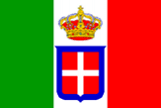

The Ensign of Italy 1848 – 1946 (fotw); The Ensign of Spain 1785-1931 (fotw)
- THE JACK
- See ‘jack, the’.
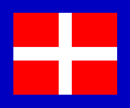
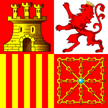
The Jack/Naval Jack 1879 – 1946, Italy (fotw);
The Jack/Naval Jack of Spain 1945 – 1977 (fotw)
- THE UNION
- See ‘union, the’.
![[Jacks - US]](../images/v/vxt-d337a.gif)
Canton of the National Flag/Traditional Jack, US (fotw)
- THIRD CANTON (or QUARTER)
- A term for that quarter of a flag which occupies the lower hoist - the third quarter,
lower hoist or lower hoist canton – see ‘canton 3)’
(also ‘hoist 1)’).
![[Third canton]](../images/v/vxt-d1576c.gif)
- THREE-STRIPED FLAG
- See ‘triband’ and ‘tricolour’.
![[three-striped flag]](../images/v/vxt-d1208.gif)
![[three-striped flag]](../images/v/vxt-d1209.gif)
![[three-striped flag]](../images/v/vxt-d2522.gif)
Flag of the Commando Training Centre Royal Marines, UK (Graham Bartram); National Flag of
Lithuania (fotw); National Flag of The Congo (fotw)
- THREE-TONGUED
- See ‘swallowtail and tongue’
(also ‘triple tongued 2)’).
![[three-tongued flag]](../images/v/vxt-d1210.gif)
Flag of Dolný Bar, Slovakia (fotw)
- THREEMOUND (or THREEMOUNT)
- See ‘coupeau’ (also ‘mount’).
![[threemound]](../images/v/vxt-d1211.gif)
Flag of Dürrenäsch, Switzerland (fotw)
- THROUGHOUT
- The heraldic term that is most usually (but not exclusively) employed when
a charge, which under ordinary circumstances does not do so, extends to the
edges of a shield, banner of arms or flag – for example a cross pattée
throughout or a lozenge throughout as illustrated below – fixed or entire
(see also ‘banner of arms’, ‘overall 1)’,
‘overall 2)’ and
‘surmounted by 2)’).
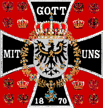
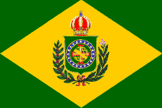
Imperial Standard 1871 - 1918, Germany (fotw); The Empire of Brazil 1822 – 1889 (fotw)
- TIERCÉ (or TIERCED)
- The heraldic term used when a shield or banner of arms is divided into three parts in two or three different
tinctures or patterns – but see ‘triband 1)’,
‘tricolour 1)’ and note below.

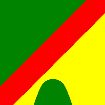
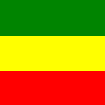
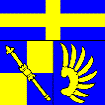
Arms of Dobrovnik, Slovenia (fotw); Flag of Gettnau, Switzerland; Flag of Mont-sur-Rolle,
Switzerland (fotw); of Flag of Correvon, Switzerland (fotw)
Please note that a field divided in tiercé
may be described in several different ways and it is suggested that a glossary
or heraldic dictionary be consulted for full details, however, among those
ways are per fess, per pale or per bend depending upon whether it is
horizontal, vertical or diagonal – see ‘bend’,
‘fess’ and ‘pale’ (also
‘per bend’ and
‘per bend sinister’).
- TIES
- Pieces of fabric or lengths of ribbon used in the largely (but not entirely)
obsolete practice of tying a flag to its staff or mast.
Please note that the increasingly (but by no means entirely) obsolete
practice of fixing a flag to its pole or staff by a series of attached loops is almost certainly based
on this earlier use of ties – but see ‘loops’ (also ‘sleeve 2)’).
- TILTED FLAG
- See ‘flag for slanted display’.
![[Pont-à-Celles]](../images/v/vxt-d1307.gif)
Flag of the Army For Slanted Display, Bolivia (fotw & CS)
- TINCTURES
- The heraldic term for the colours, metals and furs used on a shield or banner
of arms (see 'Appendix III').












From left: Gules, Azure, Vert, Purpure, Sable, Brunatre, Tenne, Or, Argent, Ermine, Potent and Vair
- TOGGLE
- An oval-shaped wood or plastic cross-piece attached to a hoist-line sewn into
the heading of a flag, that fastens to a becket or eyesplice at the upper end
of the halyard for hoisting the flag on a mast or pole (see also
‘becket’,
‘halyard’,
‘heading’,
‘hoistline’ plus
‘running eye and toggle’).
![[toggle]](../images/v/vxt-d038b.gif)
- TOGGLE AND BECKET
- See
‘running eye and toggle’.
![[becket]](../images/v/vxt-d038.gif)
- TONGUE(S)
- One or more projections extending from the fly of a flag or the bottom edge of a gonfalon, hanging flag or banner, either varying in
width/length or of even size, sometimes triangular or possibly straight-sided with rounded,
triangular or squared ends - tails (see also
‘fly 1)’, 'gonfalon',
‘gonfanon’,
'multi-tailed',
‘pallia’,
‘palm’,
‘schwenkel’,
'square-tongued',
‘stepped fly’,
‘swallow-tail(ed)’
‘swallowtail and tongue’ and
‘triangular-ended tails’).
![[tongued flag]](../images/v/vxt-d1212.gif)
![[tongued flag]](../images/v/vxt-d1958.gif)
![[tongued flag]](../images/v/vxt-d1213.gif)
Gonfalon/Ceremonial Flag of
Baska, Croatia (fotw); Flag of Beckov, Slovakia (fotw); State Flag of
Iceland (fotw)
- TONGUED
- See ‘langued’.
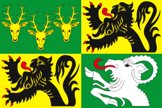
Flag of Oostrozebeke, Belgium (fotw)
- TOOTHED
- See ‘armed 2)’.
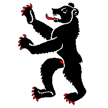
Flag of Appenzell, Switzerland (fotw)
- TOOTHED WHEEL
- See ‘cog-wheel’.

Flag of Industriequartier Zurich, Switzerland (fotw)
- TOPPED
- 1) In vexillology a term that may be used to place the uppermost detail of a charge – for example
when an orb and cross appear on the central point of a crown (see also ‘charge 2)’.
- 2) In heraldry see ‘ensigned’.
- TORSE
- A heraldic wreath - see ‘wreath 2)’.

- TORTEAU
- The heraldic term for a red disc – a roundel gules (see also
‘bezant’,
‘hurt’,
‘plates’ and
‘roundel 3)’)


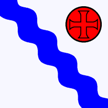
Flag of Burg, Switzerland (fotw); Flag of Niederbipp, Switzerland (fotw)
Please note that in strict English heraldic usage this term should only be
applied when the charge described in red (“gules”) – see
‘tinctures’ in ‘Appendix III:’.
- TORUS
- See ‘ring 1)’.

- TOUG
- A term for the horsetail decorated standard, now obsolete, of certain
regiments of French cavalry - the Spahis originally raised from North African
tribesmen – a tugh (see also ‘horsetail’,
‘standard 2)’ and
'tugh 1)'.
- TOURING FLAG (or BANNER)
- The term – and a translation of the German Wanderfahne – for those flags
(or more accurately banners) that were awarded to various non-military organizations
for the best performance in the meeting or exceeding of production targets etc., by the former GDR and possibly other
Communist bloc countries – but see ‘award flag’
(also ‘banner 3’ and
‘honour banner’).

Example: eBay
Please note that other translations of the term “wanderfahne” have been proposed, but
have not yet been adopted into English vexillology.
- TOWER TOWERED (or TURRETED)
- The heraldic term used when a narrower tower or turret rises above the embattled top of another
tower or turret, with the number of any such towers or turrets (if more than one) given – for
example (as per two of those shown blow) a tower triple-towered (see also
‘embattled’).



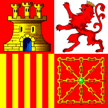

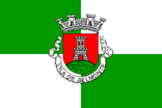
From left: Flag and Arms of Seia, Portugal (fotw
& ICA) Flag of Castile-La Mancha, Spain; Naval Jack of
Spain (fotw); Arms and Flag of
Belmonte, Portugal (Klaus-Michael Schneider & fotw)
Please note that other variants might include a tower with a
steeple or a tower domed (or with a cupola), with the example given below being a tower
triple towered with one domed.


Flag and Lesser Arms of Hamburg, Germany (fotw)





![[three-striped flag]](../images/v/vxt-d1208.gif)
![[three-striped flag]](../images/v/vxt-d1209.gif)
![[three-striped flag]](../images/v/vxt-d2522.gif)
![[three-tongued flag]](../images/v/vxt-d1210.gif)
![[threemound]](../images/v/vxt-d1211.gif)


















![[tongued flag]](../images/v/vxt-d1212.gif)
![[tongued flag]](../images/v/vxt-d1958.gif)
![[tongued flag]](../images/v/vxt-d1213.gif)















![[Jacks - US]](../images/v/vxt-d337a.gif)
![[Third canton]](../images/v/vxt-d1576c.gif)
![[Pont-à-Celles]](../images/v/vxt-d1307.gif)
![[toggle]](../images/v/vxt-d038b.gif)
![[becket]](../images/v/vxt-d038.gif)

